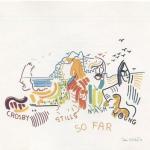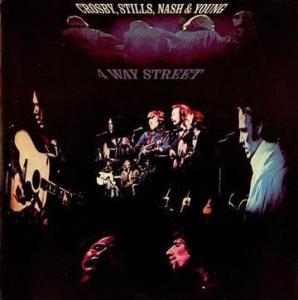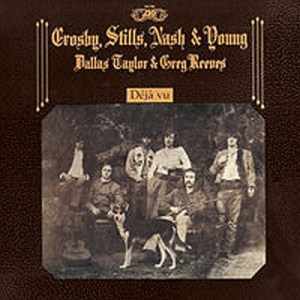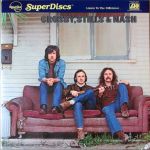 More Crosby, Stills, Nash and Young Records in Stock
More Crosby, Stills, Nash and Young Records in Stock
More Commentaries and Letters for So Far
This is a very difficult record to find with proper mastering (and good vinyl, ouch!). It seems that all of Crosby, Stills and Nash’s albums are that way. The average domestic pressing rarely even hints at how well recorded this band really was (and the imports are even worse — we’ve never heard one that didn’t sound dubby, veiled and compressed).
In my experience not even one out of ten LPs sounds right; I put the figure at one out of twenty. Most of them are shrill, dull, grainy, flat, opaque, harsh and in varying degrees suffer from every other mastering and pressing malady known to man.
But the best ones have some tracks in superb sound. When you hear the Hot Stampers for records like this you will simply be AMAZED. If you’ve ever heard a really good If Only I Could Remember My Name, an album that CAN be found with proper mastering, that should give you some idea of how good the first two albums can sound.
Side One
Déjà Vu
When you get a good copy of this album, this song sounds like it was lifted right off of a Hot Stamper copy of Deja Vu itself. It’s so rich and Tubey Magical you’d swear it couldn’t get any better. Huge amounts of deep bass. Acoustic guitars that ring for days. Midrange magic to die for. Not many of them sound this way, unfortunately.
If I could indulge in some more MoFi and Half-Speed bashing for a moment, the bass “solo” at the end of this song is a great test for bass definition. The notes are relatively high, and it’s easy for them to sound blurred and wooly. The MoFi, like virtually all Half-Speed mastered records, has a problem with bass definition. If you own the MoFi, listen for how clearly defined the notes are at the end of this track. Then play any other copy, either of So Far or Deja Vu. It’s a pretty safe bet that the bass will be much more articulate. I know how bad the MOFI is in this respect. Rarely do “normal” records have bass that bad.
Stephen Barncard Does It Again
Listen to this song and compare it to anything on the Barncard-engineered first solo LP by David Crosby. That is the sound of Barncard’s engineering — open, spacious, rich, sweet; tons of deep bass; absolutely no trace of phony eq on vocals; acoustic guitars that ring for days — the man is a GENIUS. Thank god he was involved with music of this quality. If only more of the LP pressings did a better job of revealing the exquisite beauty of the recordings themselves. (I suppose that burden must be carried by the few Hot Stamper copies we can dig up.)
Helplessly Hoping
This is a wonderful song that has a lot of energy in the midrange and upper midrange area which is difficult to get right. Just today (4/25/05) I was playing around with VTA, and this song showed me EXACTLY how to get the VTA right.
VTA is all about balance. The reason this song is so good for adjusting VTA is that the guitar at the opening is a little smooth and the harmony vocals that come in after the intro can be a little bright. Finding the balance between these two elements is key to getting the VTA adjusted properly.
When the arm is too far down in the back, the guitar at the opening will lose its transparency and become dull and thick. Too high in the back and the vocals sound thin and shrill, especially when the boys all really push their harmony parts. The slightest change in VTA will noticeably affect that balance and allow you to tune it in just right.
To be successful, however, there are also other conditions that need to be met. The system has to be sounding right, which in my world means good electricity, so make sure you do this in the evening or on a weekend when the electricity is better.
That’s the easy part. The hard part is that you need a good pressing of this song, and those don’t grow on trees. The vast majority of CSN’s first album and the vast majority of So Far’s are junk. Trying to get them to sound right is impossible, because they weren’t mastered right in the first place. But if you’re one of the lucky few who has a good pressing of Helplessly Hoping, try tweaking your VTA adjustment and see if you aren’t able to dial it in even better than before.
Since the Classic heavy vinyl version is also excellent, it too can be used to set VTA. But of course you are setting VTA for a thicker record, which means you will need to note where the setting is for thick and thin vinyl respectively and make sure that the VTA is correct for each.
As good as the Classic Record is, the guitar at the opening of Helplessly Hoping tells you everything you need to know about what’s missing. The guitar on the Hot Stamper domestic copies has a transparency that cannot be found on Classic’s version. The Classic gets the tonal balance right, but their guitar doesn’t have the subtlety and harmonic resolution of the real thing.
(more…)








 But most people will never know what they’re missing on Helplessly Hoping, because they will never have an amazing sounding copy of the album. The hot copies are just too rare.
But most people will never know what they’re missing on Helplessly Hoping, because they will never have an amazing sounding copy of the album. The hot copies are just too rare.
